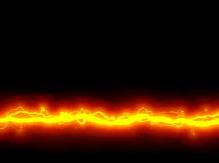In order to know the meaning of the term electric current, it is necessary, first of all, to discover the etymological origin of the two words that give it shape:
-Current derives from Latin, exactly from "currens, currentis" which can be translated as "he who runs." It is the result of the sum of two delimited parts: the verb "currere", which is synonymous with "run", and the suffix "-nte", which is used to indicate "agent".
-Electrical, for its part, was a term created by the British physicist William Gilbert. For this, it was based on the use of two components of Greek: the noun "elektron", which is synonymous with "amber", and the suffix "-ikos", which is used to indicate "relative to".
The flow of electrical charges that runs through a conductor is known as electric current . The flow is linked to the movement of electrons or protons within the material in question.
 Electrical charge is the physical property possessed by certain subatomic particles (such as protons and electrons), manifested through the forces of repulsion and attraction that exist between them through electromagnetic fields . Protons were assigned a positive electrical charge , while electrons were assigned a negative electrical charge . Protons and electrons, in this framework, flow from the negative pole to the positive pole.
Electrical charge is the physical property possessed by certain subatomic particles (such as protons and electrons), manifested through the forces of repulsion and attraction that exist between them through electromagnetic fields . Protons were assigned a positive electrical charge , while electrons were assigned a negative electrical charge . Protons and electrons, in this framework, flow from the negative pole to the positive pole.
Conductors, having numerous free electrons, allow electricity to pass through them. The movement of electric charges generates the magnetic field that can be used in different ways.
The magnitude that reflects the level of electricity that, in a unit of time , flows through the conductor, is also called electric current. This magnitude, measured by an instrument called a galvanometer , has the unit of the ampere. Therefore, if the galvanometer is calibrated in amperes, it is called an ammeter .
Electric current can be variable (if its intensity changes over time) or continuous (if the intensity remains constant). When no decrease or storage of charge is generated in any sector of the conductor, we speak of stationary current . It should be noted that the intensity of the electric current is calculated by dividing the charge (expressed in columbia) by the time (seconds) it takes to move from one place to another.
In addition to everything stated above, we cannot ignore that electric current is capable of generating different types of effects. Specifically, among the most significant the following stand out:
-Light effects, since it transforms what is electrical energy into light energy. Hence it is capable of turning on light bulbs, for example.
-Calorific effects, which is what allows you to activate everything from stoves to heaters of all types.
-Physiological effects, which can affect both animals and humans. Specifically, these are necessary for the corresponding operation of what are electromedical devices.
-Chemical effects. Specifically, electric current is capable of generating chemical changes. An example of this is what is known as electrolysis .
